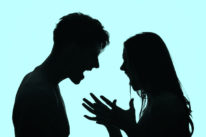
“Peace of mind is not the absence of conflict from life but the ability to cope with it.” -Unknown
When my daughter, Nava, was critically ill, on a ventilator in a drug-induced coma for three months, one of the ICU doctors called me in after a couple of weeks to tell me that if she survives, it will be a long road.
He started writing out a prescription for an anti-anxiety medication to “help” me through this horrific ordeal. I certainly don’t fault him here as this was an extreme acute situation and he didn’t know if I could manage without falling apart.
His offering of “the pill” was an awakening.
I realized I better start doing something to keep myself strong so I can function through this and be by Navi’s side. This was my impetus for gearing up into self-preservation mode.
The next day I began my walking regime around the hospital streets. I started taking 30 minutes off from sitting by Navi’s bedside listening to every beep, bleep, and gurgle, to engage in my non-medicated self-prescription program.
Truth be told, I’ve been a walker for the past 17 years, since my friend dragged to the gym the summer of my separation. I guess I was ready because it didn’t take much coercion. A bit of “c’mon get moving; it’ll do you good” was all I needed. I showed up, and have never stopped.
It became a way of life, a grounding and healthy reprieve during my divorce, my working and going to school, and dealing with the illness and disabilities of Navi’s earlier years. I found something to hold to that I felt was keeping me healthy and strong, both psychologically and physically; and exercise was it.
And so when Doctor S. pulled out his prescription pad from his pocket, I pulled my exercise tool from mine; two working legs and I was on my way.
I at least wanted to give it a shot. But mind over matter, I knew then I wasn’t starting with any pills. Side effects are a biggie with my sensitive gut.
And that is how I functioned for the next year as I spent 12–15 hour days by her bedside and through her rehabilitation.
I cried, I ranted, I raved: I walked, I sat, I prayed.
Can it be okay to feel bad? Can it be okay to curl up in a ball and cry our eyes out till we melt into sheer exhaustion? It’s surprising how giving ourselves this permission can free us up and help us move into another gear called “function.”
It’s when we push the bad feelings down inside that it festers and weighs us down. The heaviness of this load is like an anchor; it keeps us tied to it.
In rough situations we need to be freed up to do what we need to do. It’s not the (bad and painful) feelings themselves that disable us from functioning; rather it’s the expression or lack of that affects how we carry on.
Going through them can help us get through them.
Feeling bad doesn’t disempower us. We can feel bad and still be okay. But sometimes it doesn’t feel that way. These “bad” feelings can feel scary. We don’t know what to do with them and so we turn to numbing and covering them up. We don’t know that we can come through them intact.
This is where we’ve gone amuck. Everyone wants to run in and take away any bad feeling.
Parents want to protect their kids from pain, naturally so, but in the process of “bubble-wrapping” and rescuing them from experiencing pain, we rob them of coping skills—of learning that they can fall down and get back up; that they can make a mistake and learn from it; that they can come through the “scary” negative feelings in one piece.
We all have resilient muscles that must be used in order to grow stronger. Pills mute them. Rescuing mutes them.
Of course, there are illnesses which require medication. But the run-of-the-mill life situations that cause people dissatisfaction, sadness, and pain can be “treated” with life coping skills.
We have to instill these coping skills; we have to nurture them and be there for one another during those trying times.
The internist doesn’t have to pull out his pad because someone comes in complaining of (circumstantial) depression due to divorce.
I’d love to see a doctor prescribe the following for sadness and anxiety:
- Go home and have a good cry. It’s okay. to cry a lot at the beginning.
- Find a good listening ear, hopefully a good friend.
- Do some form of exercise every day ; it gets those endorphins going.
- Meditate; it brings clarity, “groundedness,” and calmness.
- Add a minimum of one thing to your day that brings you pleasure.
- Give yourself extra TLC.
- Lay off the self-imposed pressure and “should”
Frequency: practice each item at least once a day, and check back in a month.
Remember, oftentimes it’s in the struggle that we find our untapped strengths and beauty.
Photo by mara_earthlight
About Harriet Cabelly
Harriet Cabelly, LCSW is a therapist specializing in grief, loss. and critical life situations. She's also a speaker, author, and group leader. Harriet works from the lens of positive psychology and existentialism. She has a private practice seeing clients both in-person and virtually. She is passionate about helping people cope and grow through critical life-changing circumstances. Harriet is the author of Living Well Despite Adversity: Inspiration for Finding Renewed Meaning and Joy in Your Life. Visit her at rebuildlifenow.com.













 Though I run this site, it is not mine. It's ours. It's not about me. It's about us. Your stories and your wisdom are just as meaningful as mine.
Though I run this site, it is not mine. It's ours. It's not about me. It's about us. Your stories and your wisdom are just as meaningful as mine. 